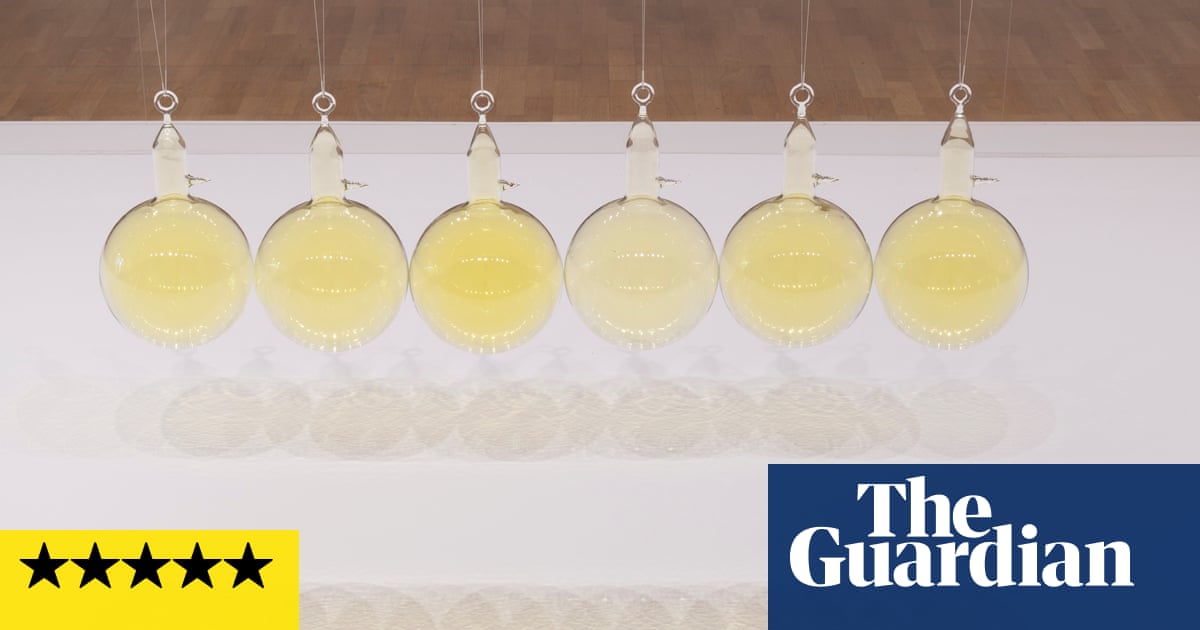Flies crawl about in a triptych of glass-fronted cabinets, while in another installation you gradually realise the fragile bottles you’re looking at are full of poisonous gas, lethal to humans. Does this remind you of anyone?
Hamad Butt is the Damien Hirst who got away, the Young British Artist of the 1990s who didn’t win the Turner prize, make millions or lose his youthful talent and turn into a bloated mediocrity. Now he is a cult figure precisely because he is none of those things and can instead be presented as if he was a complete unknown, whose art expresses his queer Pakistani identity rather than being part of afin-de-siecleart movement of sensation and creepy science. I couldn’t find any reference, even in the moving array of Butt’s working documents on show, to the fact he studied at Goldsmiths alongside Hirst, Collishaw, Wearing and more.
If we need to detach this brilliant artist from that generation to celebrate him, it’s better than forgetting his work. But as soon as you walk into this convincing retrospective you’re back in 1992. Occupying the whole of the Whitechapel’s main ground floor gallery is Butt’s three-part installation Familiars. Like a giant executive toy, spherical glass vessels are suspended from the ceiling by thin threads in a long row. Pull the first one back, as it is weirdly tempting to do, and you’d set them going by action and reaction. Except it would surely shatter these vessels and kill you, or at least make you very ill.
The coloured gas inside each sphere is mustard-coloured, as in mustard gas. This is gaseous chlorine, first used as a chemical weapon by Germany in 1915 and in these static, sealed bottles it looks lovely, golden, glowing in the gallery lights.
It’s disturbing but, let’s be honest, darkly thrilling to be only a thin glass wall away from a first world war soldier’s death here in an art gallery. To put it another way it’s sublime. One of the sculptures in this installation is actually entitled Substance Sublimation Unit, a play on chemistry and aesthetics.
The other two elements of this epic sculpture look equally hazardous: a ladder with rungs that light up with blazing gas like a stairway to hell, and three curving, blood-red glowing spikes.
To feel such beauty and violence in a gallery may strike you as shockingly new or oddly nostalgic. In the archives room there’s a 1995 Jak cartoon from the Evening Standard, depicting a dodgy geezer selling gas masks outside the Tate – a reference to a leak from this installation when it was in a show called Rites of Passage, alongside Louise Bourgeois.
Hamad Butt was not alive to laugh at Jak’s cartoon. He died in September 1994, at the age of 32, from Aids-related complications. In a video interview, lying on a sofa at his family home in Ilford, he’s still talking vividly about his future projects, months before his death. What a compelling presence he is, how deeply intelligent and imaginative.
His gripping art makes you aware of how quickly and suddenly you can stray from civilised normality to mortal danger. His installation Transmission glows with gorgeous, if clinical, blue light – but look for too long, or without the protective glasses you are offered, at its ultra-violet bulbs and you risk damaging your eyesight. The bulbs rest on a circle of opened books made of glass, on which the monstrous people-eating, world-conquering flora from John Wyndham’s novel The Day of the Triffids are engraved.
In another classic trope of Young British Art, that of appropriation, his design of a Triffid, with its fat vegetable body, long sucker and libidinous tongue, is borrowed wholesale from the cover of the original Penguin paperback of The Day of the Triffids.
Sign up toArt Weekly
Your weekly art world round-up, sketching out all the biggest stories, scandals and exhibitions
after newsletter promotion
The labels prompt you to see Hamad Butt’s art in relation to his tragic early death, so Transmission is about the Aids epidemic, and his Triffids – which also feature in a hilarious animated video – are images of the HIV crisis. However, in the video interview, he says “transmission” refers in the first place to the transmission of light. He clearly did not want his art to be understood only one way.
Today figurative painting is back in fashion, so this exhibition includes Butt’s early canvases before he turned conceptual. On the sofa on screen he explains he had to stop because he was too in thrall to Picasso and Matisse. You can see Picasso’s shadow over his paintings of sensual Minotaur-like men.
This exhibition risks removing him from his wider context, but it can’t go very wrong with such art. It’s right to include his paintings, drawings and archives because we possess so little of such magnificent promise. Hamad Butt died so long before his time, yet his work is a living thrill. He is the Young British Artist who is for ever young, for ever lethal.
Hamad Butt: Apprehensions is atWhitechapel Art Gallery, London, from 4 June to 7 September
